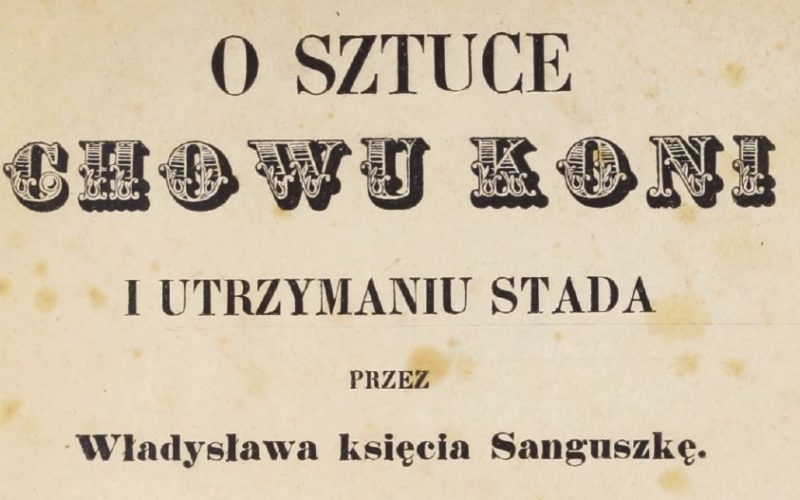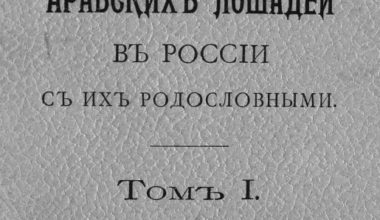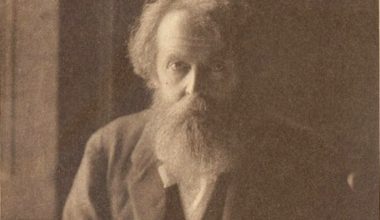O sztuce chowu koni i utrzymaniu stada
By Prince Władysław Sanguszko
Published by the author, Cracow, 1850, pages 12-15.
Edited by Lyman Doyle. Translated from Polish by David Rygielski.
Editor’s Note
Prince Wladyslaw Sanguszko (1803-1870) was the brother of Prince Roman Sanguszko Sr. (1800-1881). They are the son’s of Prince Eustachy Sanguszko (1768-1844) and grandson’s of Prince Hieronim Sangsuzko (1743-1812). He wrote this book of which Chapter 5 is translated below at the age of 47.
Prince W. Sanguszko gives more details in this 1850 document than he did in a similar book published in 1839 about the potential origin of two of Skowronek’s ancestors, “Szumka” and “Zbój.” “Zbój” is a clear Skowronek ancestor however its not completely clear if the “Szumka” mentioned below refers to the “Szumka 1” in Skowronek’s pedigree. From the text below we understand the following about these horses:
- Szumka and Zbój lived at the same time and were used as a sire in the Sanguszko herd for 15 years.
- Szumka’s sire was half “Arab.”
- Szumka’s dam was an English mare.
- Szumka was born at W. Sanguszko’s grandfather’s stud. His grandfather was Hieronim Sangsuzko (1743-1812). Prince Wladyslaw would have been 9 years old at the time of his grandfather’s death.
- Zbój’s provenance was unknown. He was captured by Russian solider’s during a battle with the Ottoman Army. Sanguszko indicates that Zbój looked like a Turkoman horse, born in Asia Minor and came from high quality blood.
- In the author’s judgement, Szumka and Zbój were unsuccessful as sires within the Sanguszko family herd.
- In terms of blood, Szumka was closer to the mares of the Sanguszko herd than Zbój, a mix of Arab, English and other blood not mentioned.
The translation follows:
§5.
Having found that mixing races is a harmful thing, let’s turn our attention to the choice of stallion. The stallion has to be of a race close to the race of the mare which he is to settle, while not being their relative. If you use closely related stallions, the herd needs its blood to be refreshed more often – by a foreign[1] stallion, not at all related. The stallion should therefore not be a relative of the mare, but he should be from a lineage just as noble as the mare, if not better. If you let our stallion, or an Arab one, onto a German or Normand mare, it won’t be just that the foetus will be bad, but also the stallion will hesitate and not want to settle the mare, and it is rare that the mare will be bred. The herd owner should not be taken by the beauty or the individual properties of the stallion that he wants to use but try to acquire sufficient information about his sire and dam; as you can be sure that the stallion’s own properties, whether good or bad, are less important than the properties and quality of his parents and ancestors. It is not without reason that Englishmen and Arabs keep evidence of the whole family line: it is a matter of the highest importance, and no herd retain its high quality if the lineage is not kept in the highest order.
I will allow myself to recall two striking examples to support what I said about mixing races, as well as the individual properties of the stallion.
Many fans of horses have known or heard of two famous stallions, living at the same time in the same stable in Wołyń. One was black without an imperfection and named Szumka, the other was white as milk, named Zbój. Although these two were nothing like each other, had one commonality: nobody would be able to find any imperfection in them, or even think of a property that these did not have.
I have never seen a stronger and more courageous horse than Zbój, and Szumka is still the most people horse that has graced my eyes in my long life. Szumka’s sire was a son of an Arab horse, while his dam was an English mare. Szumka himself was born at my grandfather’s stud in Sławuta. The provenance of Zbój was quite unknown, since the Turk who was riding him died in battle, and the horse was captured from Russian soldiers. For the experts, it was undoubtable that he was a Turkman[2] horse, born in Asia Minor, and came from the finest herds of that region. Both of these stallions were used in the same herd for more than fifteen years, and even though they were given the finest mares, no good descendants ever came. Zbój’s descendants were all damaged or imperfect without exception. Szumka, whose lineage was closer to the rest of the herd, only managed a few mares that could be used in the herd.
To further support my opinion with examples, I could list more than one ugly, badly built stallion, who left fine descendants behind, only because he came from good and noble sire and dam.


